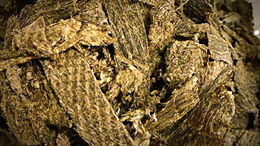Ch'arki

Ch'arki

Peruvian combo plate: from lower left, clockwise: Sangrecita (blood stew), rice, olluquito with charqui, Cau-cau (rumen stew), and chanfainita (diced beef lung stew with potatoes)
Ch'arki (Quechua for dried, salted meat,[1] Hispanicized spellings charque, charqui, charquí) is dried and salted meat common in South America, originally llama, nowadays mostly horse[2] and beef. Llama is still widely used in Bolivia. This was a very popular way to preserve meat in Argentina, Bolivia, Chile, Ecuador, Peru, Uruguay and Brazil. It was industrialized in charqueadas, also named saladeros (in Argentina and Uruguay). In the United States ch'arki was Anglicised as jerky.[3][4]
When encountered by the Spanish, the Inca Empire supplied tampu (inns) along the Inca road system with llama ch'arki for travelers. The Inca used a freeze drying process that took advantage of their cold dry mountain air and strong sun.
See also
- Jerky
- Jerk (cooking)
- Biltong
- List of dried foods
 Food portal
Food portal
- Pizza
References
^ Teofilo Laime Ajacopa, Diccionario Bilingüe Iskay simipi yuyayk'ancha, La Paz, 2007 (Quechua-Spanish dictionary)
^ Rodney Palmer (2008). Street Art Chile. Eight Books Ltd. pp. 70–. ISBN 978-0-9554322-1-7..mw-parser-output cite.citation{font-style:inherit}.mw-parser-output q{quotes:"""""""'""'"}.mw-parser-output code.cs1-code{color:inherit;background:inherit;border:inherit;padding:inherit}.mw-parser-output .cs1-lock-free a{background:url("//upload.wikimedia.org/wikipedia/commons/thumb/6/65/Lock-green.svg/9px-Lock-green.svg.png")no-repeat;background-position:right .1em center}.mw-parser-output .cs1-lock-limited a,.mw-parser-output .cs1-lock-registration a{background:url("//upload.wikimedia.org/wikipedia/commons/thumb/d/d6/Lock-gray-alt-2.svg/9px-Lock-gray-alt-2.svg.png")no-repeat;background-position:right .1em center}.mw-parser-output .cs1-lock-subscription a{background:url("//upload.wikimedia.org/wikipedia/commons/thumb/a/aa/Lock-red-alt-2.svg/9px-Lock-red-alt-2.svg.png")no-repeat;background-position:right .1em center}.mw-parser-output .cs1-subscription,.mw-parser-output .cs1-registration{color:#555}.mw-parser-output .cs1-subscription span,.mw-parser-output .cs1-registration span{border-bottom:1px dotted;cursor:help}.mw-parser-output .cs1-hidden-error{display:none;font-size:100%}.mw-parser-output .cs1-visible-error{font-size:100%}.mw-parser-output .cs1-subscription,.mw-parser-output .cs1-registration,.mw-parser-output .cs1-format{font-size:95%}.mw-parser-output .cs1-kern-left,.mw-parser-output .cs1-kern-wl-left{padding-left:0.2em}.mw-parser-output .cs1-kern-right,.mw-parser-output .cs1-kern-wl-right{padding-right:0.2em}
^ http://etimologias.dechile.net/?charqui
^ "Archived copy" (PDF). Archived from the original (PDF) on 2010-07-01. Retrieved 2012-03-29.CS1 maint: Archived copy as title (link)
This meat-related article is a stub. You can help Wikipedia by expanding it. |